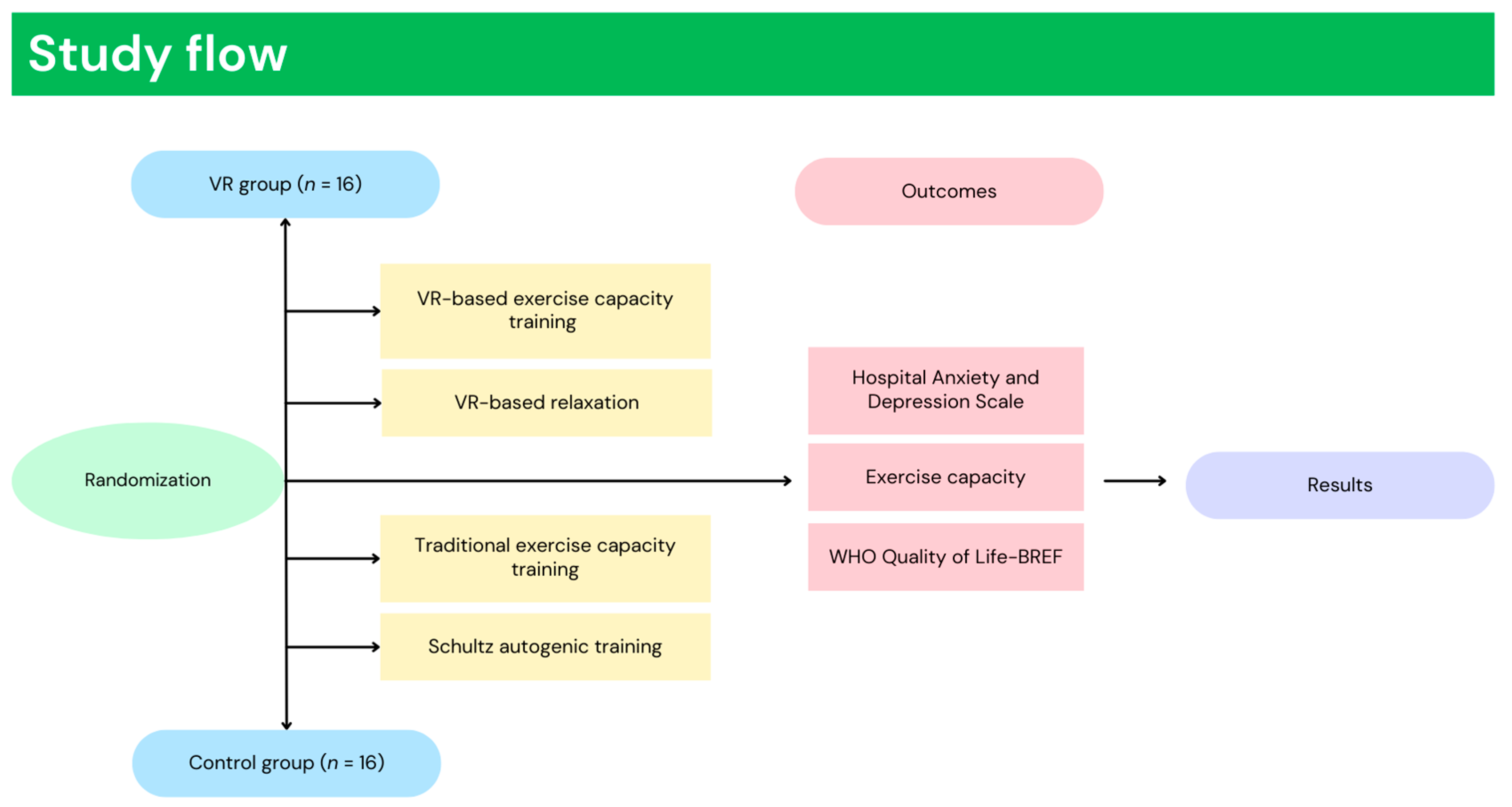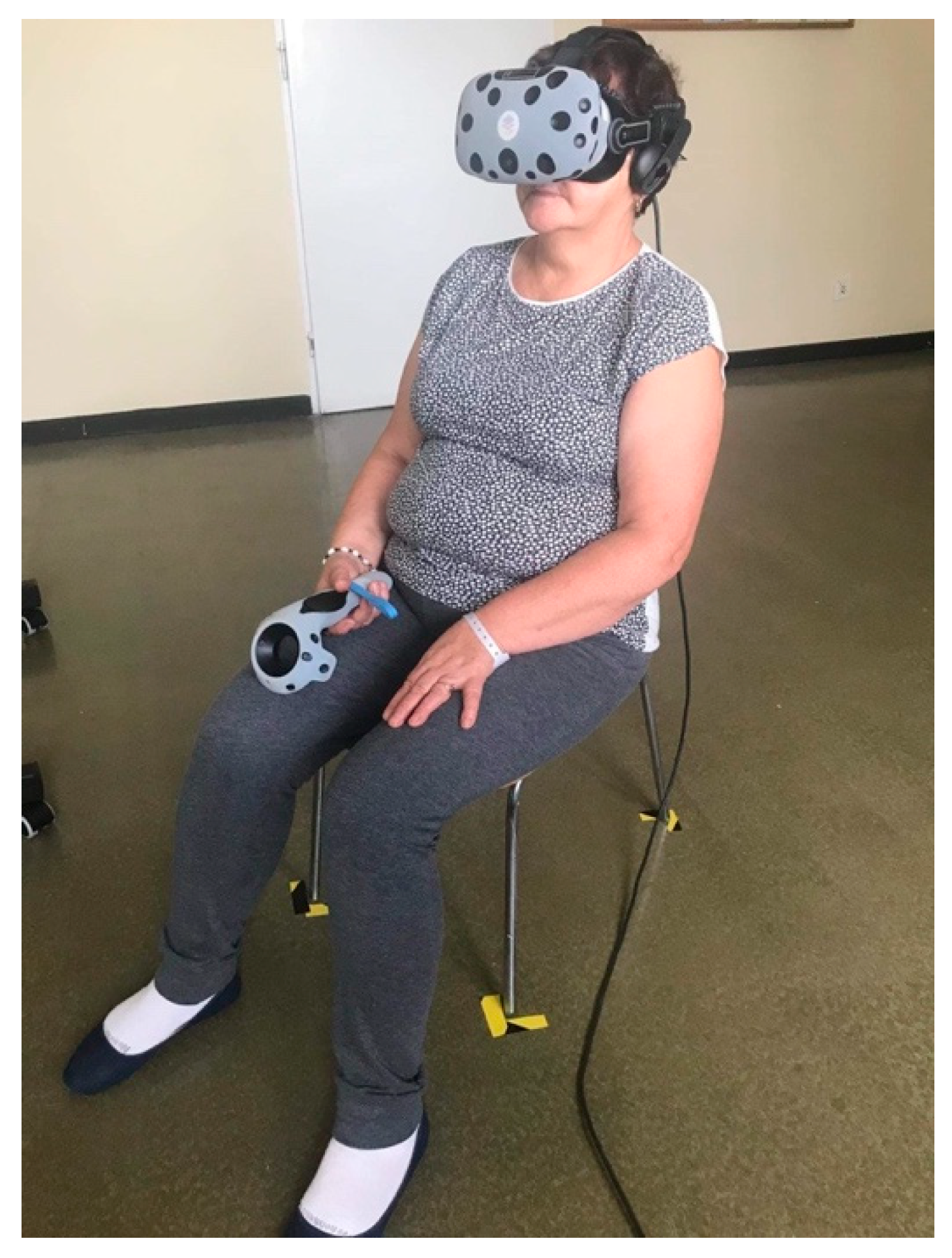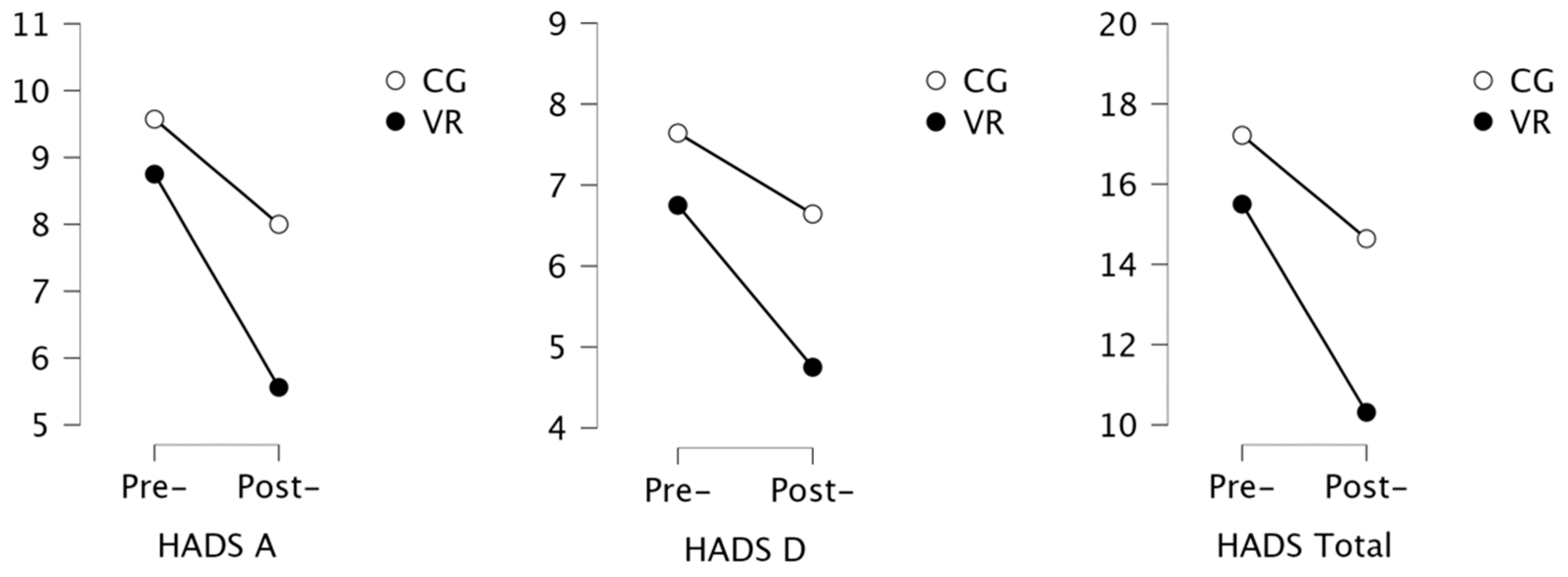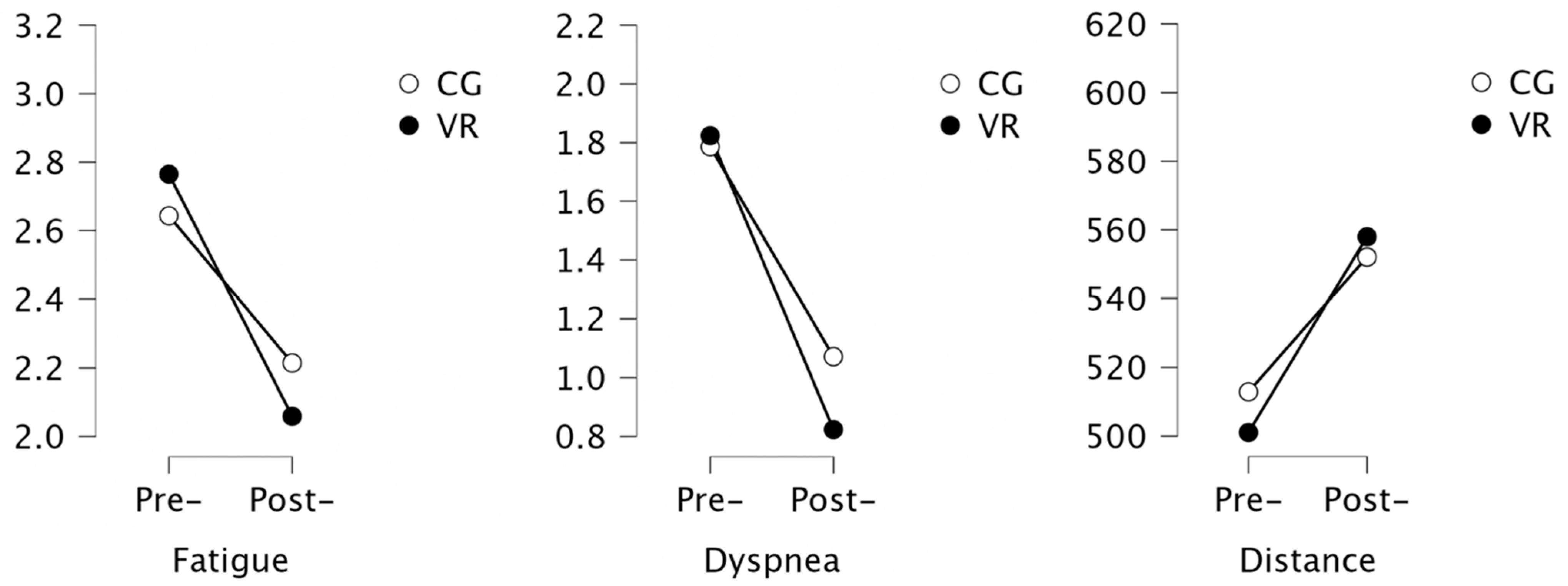Effectiveness of an Inpatient Virtual Reality-Based Pulmonary Rehabilitation Program among COVID-19 Patients on Symptoms of Anxiety, Depression and Quality of Life: Preliminary Results from a Randomized Controlled Trial
Abstract
1. Introduction
2. Materials and Methods
2.1. Participants
2.2. Interventions
2.2.1. Relaxation in Virtual Reality
2.2.2. Exercise Training in VR
2.3. Measurement
2.3.1. Hospital Anxiety and Depression Scale
2.3.2. WHO Quality of Life-BREF
2.3.3. Exercise Capacity
2.4. Statistical Analysis
3. Results
3.1. Characteristics of the Group
3.2. Assessment of Depression and Anxiety
3.3. Assessment of Quality of Life
3.4. Assessment of Functional Capacity
3.5. Predictors
4. Discussion
4.1. Results Interpretation
4.2. Discussion of Related Research
4.3. Limitations
5. Conclusions
Author Contributions
Funding
Institutional Review Board Statement
Informed Consent Statement
Data Availability Statement
Conflicts of Interest
References
- Li, Q.; Guan, X.; Wu, P.; Wang, X.; Zhou, L.; Tong, Y.; Ren, R.; Leung, K.S.M.; Lau, E.H.Y.; Wong, J.Y.; et al. Early Transmission Dynamics in Wuhan, China, of Novel Coronavirus-Infected Pneumonia. N. Engl. J. Med. 2020, 382, 1199–1207. [Google Scholar] [CrossRef] [PubMed]
- Guo, Y.R.; Cao, Q.D.; Hong, Z.S.; Tan, Y.Y.; Chen, S.D.; Jin, H.J.; Tan, K.S.; Wang, D.Y.; Yan, Y. The origin, transmission and clinical therapies on coronavirus disease 2019 (COVID-19) outbreak—An update on the status. Mil. Med. Res. 2020, 7, 11. [Google Scholar] [CrossRef] [PubMed]
- Carfi, A.; Bernabei, R.; Landi, F.; Gemelli Against, C.-P.-A.C.S.G. Persistent Symptoms in Patients after Acute COVID-19. JAMA 2020, 324, 603–605. [Google Scholar] [CrossRef] [PubMed]
- Maunder, R.; Hunter, J.; Vincent, L.; Bennett, J.; Peladeau, N.; Leszcz, M.; Sadavoy, J.; Verhaeghe, L.M.; Steinberg, R.; Mazzulli, T. The immediate psychological and occupational impact of the 2003 SARS outbreak in a teaching hospital. CMAJ 2003, 168, 1245–1251. [Google Scholar]
- Zheng, W. Mental health and a novel coronavirus (2019-nCoV) in China. J. Affect. Disord. 2020, 269, 201–202. [Google Scholar] [CrossRef]
- Demeco, A.; Marotta, N.; Barletta, M.; Pino, I.; Marinaro, C.; Petraroli, A.; Moggio, L.; Ammendolia, A. Rehabilitation of patients post-COVID-19 infection: A literature review. J. Int. Med. Res. 2020, 48, 300060520948382. [Google Scholar] [CrossRef]
- Chen, H.; Shi, H.; Liu, X.; Sun, T.; Wu, J.; Liu, Z. Effect of Pulmonary Rehabilitation for Patients with Post-COVID-19: A Systematic Review and Meta-Analysis. Front. Med. (Lausanne) 2022, 9, 837420. [Google Scholar] [CrossRef]
- Spruit, M.A.; Holland, A.E.; Singh, S.J.; Tonia, T.; Wilson, K.C.; Troosters, T. COVID-19: Interim Guidance on Rehabilitation in the Hospital and Post-Hospital Phase from a European Respiratory Society and American Thoracic Society-coordinated International Task Force. Eur. Respir. J. 2020, 56, 2002197. [Google Scholar] [CrossRef]
- World Medical Association. World Medical Association Declaration of Helsinki: Ethical principles for medical research involving human subjects. JAMA 2013, 310, 2191–2194. [Google Scholar] [CrossRef]
- Greulich, T.; Koczulla, A.R.; Nell, C.; Kehr, K.; Vogelmeier, C.F.; Stojanovic, D.; Wittmann, M.; Schultz, K. Effect of a Three-Week Inpatient Rehabilitation Program on 544 Consecutive Patients with Very Severe COPD: A Retrospective Analysis. Respiration 2015, 90, 287–292. [Google Scholar] [CrossRef]
- Szczegielniak, J.; Latawiec, K.J.; Luniewski, J.; Stanislawski, R.; Bogacz, K.; Krajczy, M.; Rydel, M. A study on nonlinear estimation of submaximal effort tolerance based on the generalized MET concept and the 6MWT in pulmonary rehabilitation. PLoS ONE 2018, 13, e0191875. [Google Scholar] [CrossRef]
- Rutkowska, A.; Jastrzebski, D.; Rutkowski, S.; Zebrowska, A.; Stanula, A.; Szczegielniak, J.; Ziora, D.; Casaburi, R. Exercise Training in Patients with Non-Small Cell Lung Cancer During In-Hospital Chemotherapy Treatment: A RANDOMIZED CONTROLLED TRIAL. J. Cardiopulm. Rehabil. Prev. 2019, 39, 127–133. [Google Scholar] [CrossRef] [PubMed]
- Rutkowski, S.; Buekers, J.; Rutkowska, A.; Cieślik, B.; Szczegielniak, J. Monitoring physical activity with a wearable sensor in patients with copd during in-hospital pulmonary rehabilitation program: A pilot study. Sensors 2021, 21, 2742. [Google Scholar] [CrossRef] [PubMed]
- Szczegielniak, J.; Bogacz, K.; Majorczyk, E.; Szczegielniak, A.; Luniewski, J. Post-COVID-19 rehabilitation—A Polish pilot program. Med. Pr. 2021, 72, 611–616. [Google Scholar] [CrossRef] [PubMed]
- Mazurek, J.; Kiper, P.; Cieslik, B.; Rutkowski, S.; Mehlich, K.; Turolla, A.; Szczepanska-Gieracha, J. Virtual reality in medicine: A brief overview and future research directions. Hum. Mov. 2019, 20, 16–22. [Google Scholar] [CrossRef]
- Rutkowski, S.; Szczegielniak, J.; Szczepanska-Gieracha, J. Evaluation of the efficacy of immersive virtual reality therapy as a method supporting pulmonary rehabilitation: A randomized controlled trial. J. Clin. Med. 2021, 10, 352. [Google Scholar] [CrossRef]
- Jozwik, S.; Cieslik, B.; Gajda, R.; Szczepanska-Gieracha, J. The Use of Virtual Therapy in Cardiac Rehabilitation of Female Patients with Heart Disease. Medicina 2021, 57, 768. [Google Scholar] [CrossRef] [PubMed]
- Colombo, V.; Aliverti, A.; Sacco, M. Virtual reality for COPD rehabilitation: A technological perspective. Pulmonology 2022, 28, 119–133. [Google Scholar] [CrossRef] [PubMed]
- Mihalca, A.M.; Pilecka, W. The factorial structure and validity of the Hospital Anxiety and Depression Scale (HADS) in Polish adolescents. Psychiatr. Pol. 2015, 49, 1071–1088. [Google Scholar] [CrossRef] [PubMed]
- Olsson, I.; Mykletun, A.; Dahl, A.A. The Hospital Anxiety and Depression Rating Scale: A cross-sectional study of psychometrics and case finding abilities in general practice. BMC Psychiatry 2005, 5, 46. [Google Scholar] [CrossRef]
- Bjelland, I.; Dahl, A.A.; Haug, T.T.; Neckelmann, D. The validity of the Hospital Anxiety and Depression Scale. An updated literature review. J. Psychosom. Res. 2002, 52, 69–77. [Google Scholar] [CrossRef] [PubMed]
- Skevington, S.M.; Lotfy, M.; O’Connell, K.A. The World Health Organization’s WHOQOL-BREF quality of life assessment: Psychometric properties and results of the international field trial. A report from the WHOQOL group. Qual. Life Res. 2004, 13, 299–310. [Google Scholar] [CrossRef] [PubMed]
- Singh, S.J.; Puhan, M.A.; Andrianopoulos, V.; Hernandes, N.A.; Mitchell, K.E.; Hill, C.J.; Lee, A.L.; Camillo, C.A.; Troosters, T.; Spruit, M.A.; et al. An official systematic review of the European Respiratory Society/American Thoracic Society: Measurement properties of field walking tests in chronic respiratory disease. Eur. Respir. J. 2014, 44, 1447–1478. [Google Scholar] [CrossRef] [PubMed]
- JASP Team. JASP (Version 0.16.3) [Computer software]. 2022. Available online: https://jasp-stats.org/ (accessed on 2 October 2022).
- Gaggioli, A.; Pallavicini, F.; Morganti, L.; Serino, S.; Scaratti, C.; Briguglio, M.; Crifaci, G.; Vetrano, N.; Giulintano, A.; Bernava, G.; et al. Experiential virtual scenarios with real-time monitoring (interreality) for the management of psychological stress: A block randomized controlled trial. J. Med. Internet Res. 2014, 16, e167. [Google Scholar] [CrossRef] [PubMed]
- Cohen, J. Statistical Power Analysis for the Behavioral Sciences, 2nd ed.; L. Erlbaum Associates: Hillsdale, NJ, USA, 1988; p. xxi. 567p. [Google Scholar]
- Liu, K.; Zhang, W.; Yang, Y.; Zhang, J.; Li, Y.; Chen, Y. Respiratory rehabilitation in elderly patients with COVID-19: A randomized controlled study. Complement Ther. Clin. Pract. 2020, 39, 101166. [Google Scholar] [CrossRef]
- Panagioti, M.; Scott, C.; Blakemore, A.; Coventry, P.A. Overview of the prevalence, impact, and management of depression and anxiety in chronic obstructive pulmonary disease. Int. J. Chron. Obstruct. Pulmon. Dis. 2014, 9, 1289–1306. [Google Scholar] [CrossRef]
- Abasıyanık, Z.; Kurt, M.; Kahraman, T. COVID-19 and Physical Activity Behaviour in People with Neurological Diseases: A Systematic Review. J. Dev. Phys. Disabil. 2022, 34, 987–1012. [Google Scholar] [CrossRef]
- Argüder, E.; Kılıç, H.; Civak, M.; Kacar, D.; Kaya, G.; Yılmaz, A.; Kayaaslan, B.; Karakaş Uğurlu, G.; Ateş, İ.; Güner, R.; et al. Anxiety and Depression Levels in Hospitalized Patients due to COVID-19 Infection. Ank. Med. J. 2020, 20, 971–981. [Google Scholar] [CrossRef]
- Huang, C.; Huang, L.; Wang, Y.; Li, X.; Ren, L.; Gu, X.; Kang, L.; Guo, L.; Liu, M.; Zhou, X.; et al. 6-month consequences of COVID-19 in patients discharged from hospital: A cohort study. Lancet 2021, 397, 220–232. [Google Scholar] [CrossRef]
- Xiong, Q.; Xu, M.; Li, J.; Liu, Y.; Zhang, J.; Xu, Y.; Dong, W. Clinical sequelae of COVID-19 survivors in Wuhan, China: A single-centre longitudinal study. Clin. Microbiol. Infect. 2021, 27, 89–95. [Google Scholar] [CrossRef]






| Variables | Mean (SD) |
|---|---|
| Age (years) | 57.8 (4.9) |
| Female, n (%) | 20 (68.75%) |
| FVC (L) | 3.47 (0.65) |
| FEV1 (L) | 2.76 (0.48) |
| FEV1% VC | 84.6 (4.31) |
| TLC (%) | 5.06 (0.98) |
| Variable | VR Group | Control Group | |||||
|---|---|---|---|---|---|---|---|
| Pre- | Post- | p | Pre- | Post- | p | Cohen’s d | |
| HADS-A mean (SD) | 8.6 (4.6) | 5.6 (3.3) | <0.001 | 9.57 (6.0) | 8 (4.8) | 0.003 | 0.595 |
| HADS-D mean (SD) | 6.9 (3.9) | 4.7 (3.5) | 0.008 | 7.64 (4.5) | 6.6 (4.8) | 0.017 | 0.457 |
| HADS Total mean (SD) | 15.5 (7.5) | 10.3 (6.5) | <0.001 | 17.2 (9.8) | 14.6 (8.9) | <0.05 | 0.559 |
| Variable | VR Group | Control Group | |||||
|---|---|---|---|---|---|---|---|
| Pre- | Post- | p | Pre- | Post- | p | Cohen’s d | |
| Physical health | 50.8 (11.3) | 51.8 (9.8) | 0.618 | 47.9 (11.8) | 52.5 (11.6) | 0.154 | 0.164 |
| Psychological health | 59.8 (13) | 59.4 (12) | 0.906 | 57.5 (14.3) | 58.1 (15.5) | 0.966 | 0.043 |
| Social relationship | 71.4 (14.1) | 71.8 (9.1) | 0.838 | 67.9 (19.5) | 73.1 (17.5) | 0.174 | 0.005 |
| Environmental | 64.4 (19) | 68.2 (16) | 0.168 | 65.4 (19) | 68 (15) | 0.028 | 0.064 |
| Variable | VR Group | Control Group | |||||
|---|---|---|---|---|---|---|---|
| Pre- | Post- | p | Pre- | Post- | p | Cohen’s d | |
| Fatigue | 2.78 (1.06) | 2.06 (0.90) | 0.055 | 2.64 (1.08) | 2.21 (0.70) | 0.095 | 0.191 |
| Dyspnea | 1.72 (1.52) | 0.82 (1.13) | 0.033 | 1.78 (1.48) | 1.07 (1.2) | 0.061 | 0.213 |
| Distance | 502 (48.4) | 558 (76) | <0.001 | 512 (54.3) | 552 (49.1) | 0.006 | −0.091 |
| Variable | B | Beta | t | p | F | R2 |
|---|---|---|---|---|---|---|
| Change in HADS Total | <0.001 | 11.293 | 0.455 | |||
| Baseline HADS A | −1.035 | −0.770 | −4.737 | |||
| Fatigue | −2.885 | −0.428 | −2.634 |
Publisher’s Note: MDPI stays neutral with regard to jurisdictional claims in published maps and institutional affiliations. |
© 2022 by the authors. Licensee MDPI, Basel, Switzerland. This article is an open access article distributed under the terms and conditions of the Creative Commons Attribution (CC BY) license (https://creativecommons.org/licenses/by/4.0/).
Share and Cite
Rutkowski, S.; Bogacz, K.; Czech, O.; Rutkowska, A.; Szczegielniak, J. Effectiveness of an Inpatient Virtual Reality-Based Pulmonary Rehabilitation Program among COVID-19 Patients on Symptoms of Anxiety, Depression and Quality of Life: Preliminary Results from a Randomized Controlled Trial. Int. J. Environ. Res. Public Health 2022, 19, 16980. https://doi.org/10.3390/ijerph192416980
Rutkowski S, Bogacz K, Czech O, Rutkowska A, Szczegielniak J. Effectiveness of an Inpatient Virtual Reality-Based Pulmonary Rehabilitation Program among COVID-19 Patients on Symptoms of Anxiety, Depression and Quality of Life: Preliminary Results from a Randomized Controlled Trial. International Journal of Environmental Research and Public Health. 2022; 19(24):16980. https://doi.org/10.3390/ijerph192416980
Chicago/Turabian StyleRutkowski, Sebastian, Katarzyna Bogacz, Oliver Czech, Anna Rutkowska, and Jan Szczegielniak. 2022. "Effectiveness of an Inpatient Virtual Reality-Based Pulmonary Rehabilitation Program among COVID-19 Patients on Symptoms of Anxiety, Depression and Quality of Life: Preliminary Results from a Randomized Controlled Trial" International Journal of Environmental Research and Public Health 19, no. 24: 16980. https://doi.org/10.3390/ijerph192416980
APA StyleRutkowski, S., Bogacz, K., Czech, O., Rutkowska, A., & Szczegielniak, J. (2022). Effectiveness of an Inpatient Virtual Reality-Based Pulmonary Rehabilitation Program among COVID-19 Patients on Symptoms of Anxiety, Depression and Quality of Life: Preliminary Results from a Randomized Controlled Trial. International Journal of Environmental Research and Public Health, 19(24), 16980. https://doi.org/10.3390/ijerph192416980








